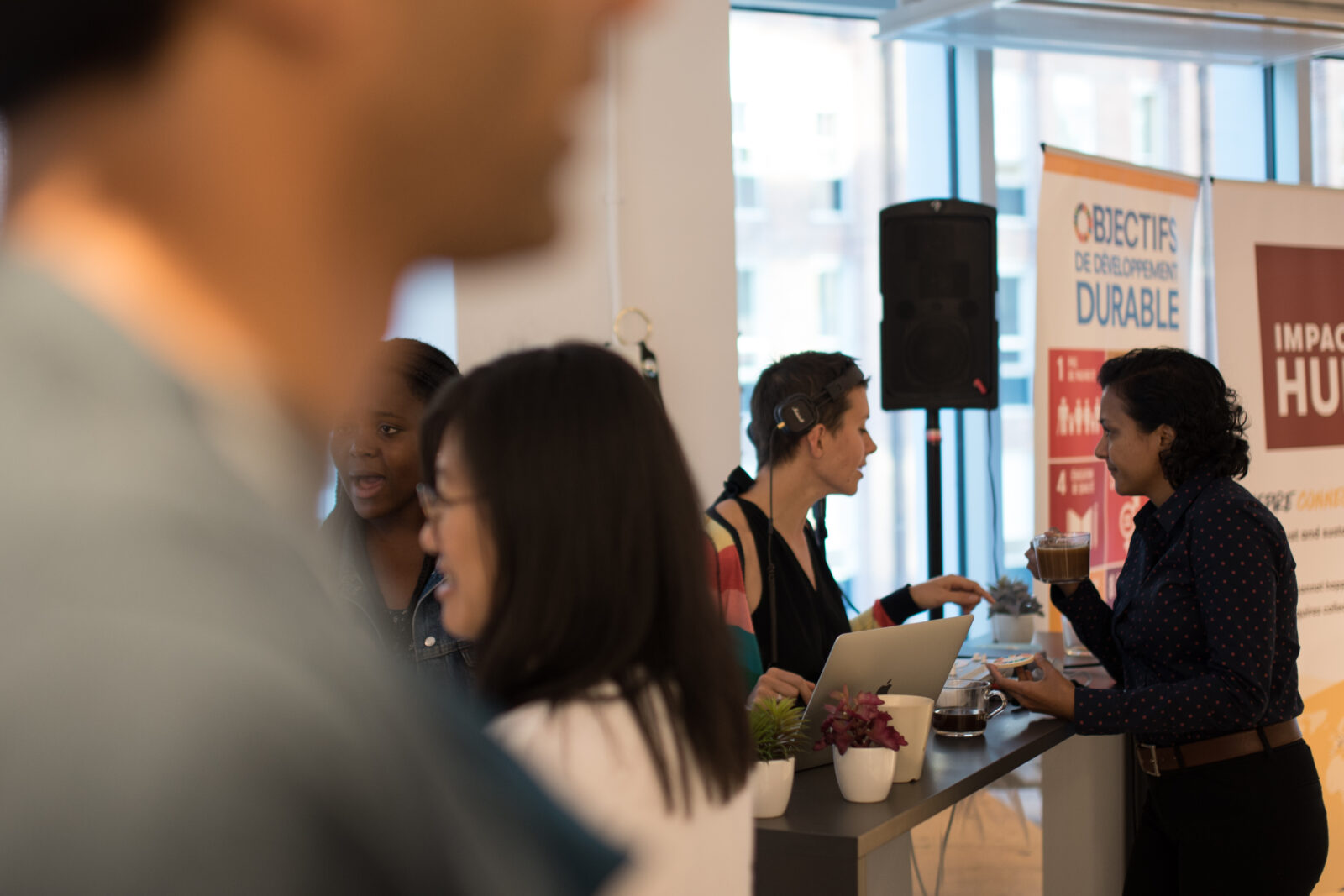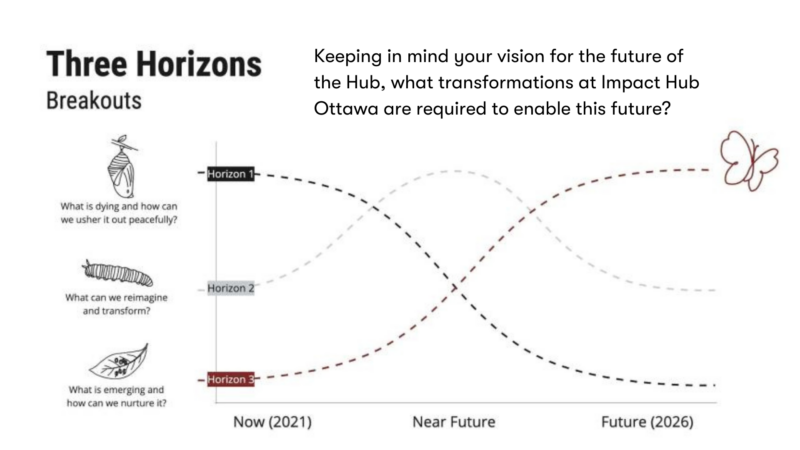
To Face Historic Challenges, We Need Grassroots Collaboration. Here’s How.
More than ever, you’re leaning on community to keep you healthy, connected, and supported through this pandemic.
Community is at the heart of social impact. And, over the last few years, we have committed to better serving ours by making our space more inclusive.
So that’s what we’re doing: improving the accessibility of our physical and digital space at Impact Hub Ottawa, and launching a new website to spotlight our new direction.
Our mission? Fueling social and environmental justice, with the UN’s Sustainable Development Goals (SDGs) as our guiding framework to facilitate the grassroots, cross-sector collaboration required to face today’s historic challenges.
To build a more inclusive space, we knew we had to co-create it with the diverse communities we want to serve. So, in partnership with Eva Oloumi—one of our coaches, and the founder of Paradeigma—we launched “Co-Designing the Future at the Hub,” two participatory design sessions in December 2021.
Want to improve your community engagement, but don’t know where to start? Members can connect with Eva here.
Partners, stakeholders and community members joined us to identify and prioritize opportunities to bring our shared vision to life, while centring a commitment to truth and reconciliation and challenging the SDGs’ limitations for equity-seeking groups.
We learned a lot. From how language informs how you see the world, to the power of vision-making to drive action, we’re excited to share our insights with you here.
Built by, and for, community leaders
A social impact consultant, data tech and design expert, community organiser, associate director and technology executive walk into a bar…
Just kidding.
These fine folks are actually the community leaders who helped design our sessions, ensuring that they’d be inclusive and engaging for folks from diverse backgrounds.
A huge thank you to:
- WEKH Indigenous’ Associate Director Ashley Richard,
- Social Impact Consultant Alicia M. Richins,
- Data Tech and Design Expert Lisa Deacon,
- Community Organiser Celeste Alcena, and
- Technology Director Brett Tackaberry.
Now, shall we begin?
How to speak—and see—the future to life
In sustainability and justice, language is crucial to conveying a subject’s importance, particularly to folks just learning about it. If you’re a member of a historically marginalized group, this can also come with the burden of digging up your trauma for strangers to secure their support.
It’s why allies must use their privilege to advocate for these groups, and why our first exercise was all about—you guessed it—language.
Terms of art
With support from ESDC’s Sustainable Development Goals Funding Program, this project is helping us become a place that better supports inclusive, cross-sector collaboration on the SDGs.
So our participants can better understand, build trust and collaborate with diverse groups, we facilitated an exercise where they went beyond what people say to why they say it.
In groups, they investigated Terms of Art (technical jargon) commonly used to address the complex environmental and social issues faced by the communities we serve: collaboration, decolonization, justice, inclusion, momentum, and sustainability.
This investigation was done with words, pictures and metaphors to really dig into what these words meant to participants. These terms are heavy, so we were guided to approach them with empathy, curiosity and an open mind, while establishing that prejudiced behaviour wouldn’t be tolerated.
A participant from the “inclusion” group described how these efforts to create a brave space made it so their conversation erupted with compassion and generosity. Others from the “justice” and “inclusion” groups realised how their interpretation of these terms were coloured by their experiences—whether they’re Indigenous or an immigrant whose parents fled the colonisation of their country to settle in Canada.
Through these sessions, we learned how to create brave spaces for open, honest conversations where historically marginalised groups are empowered to share their diversity of perspectives, challenge the status quo and introduce the new ideas we need to make an impact on our most pressing global issues.
Build a there
Language and imagery help you imagine experiences, futures, and even societies that might not yet exist.
In “build a there,” our participants did just that, envisioning a future, five years from now, where we succeeded in better supporting inclusive, cross-sector collaboration for the SDGs.

Image credit: Paradeigma, 2021
Using the Three Horizons model, here’s what we saw:
Horizon one: Today. What is emerging, and how can we nurture it?
- Continue inviting a greater diversity of people to work and benefit from the space and services at Impact Hub Ottawa.
- Increase Indigenous presence, meaningfully engaging leaders and infusing practices into our space and work (i.e. set up rooms in circles to encourage dialogue, respect, and a sense of communion).
Horizon two: Transition. What have we grown out of? What will get us from the present to the future?
- Accessibility is critical.
- Improve engagement with people outside Ottawa’s downtown core.
- Offer mental and emotional support to people in our community.
- Further adopt technology solutions to enable collaboration in a virtual world.
- Explore sponsored memberships for members of historically marginalised groups.
Horizon three: Transformative change. Your personal vision of an ideal future. What can we reimagine or transform?
- Foster true inclusion.
- Reframe concepts around “professionalism” and social innovation/social entrepreneurship to go beyond colonial, Euro-centric models and introduce other worldviews.
- Invite Indigenous leaders, artists and activists to integrate practices, decolonizing our culture.
Through this activity, our participants helped us see what we should keep doing, need to change, and must leave behind to bring this vision to life at Impact Hub Ottawa.
From what could be, to what we can make real
Blue-sky thinking helps you consider: At our best, what can we be? Who can we serve? And how?
That’s why we hosted these co-designing sessions: to work with our community to make ours the go-to space for social impact leaders like you to collaborate and do good, better.
When you become a member at Impact Hub Ottawa, you join a community that’s constantly imagining what a better tomorrow can look like, and working together to make this vision real.
In our next blog in this series, you’ll learn how we’re taking these visions and exploring the immediate steps we can take to bring about the change we want to see in the world. We’ll see you there.
This co-design process was guided with the support of Eva Oloumi, founder of Paradeigma and Impact Hub Ottawa’s Strategy, Systems Transformation & Collaborative Design Coach. Members can book a 1:1 session with her here.